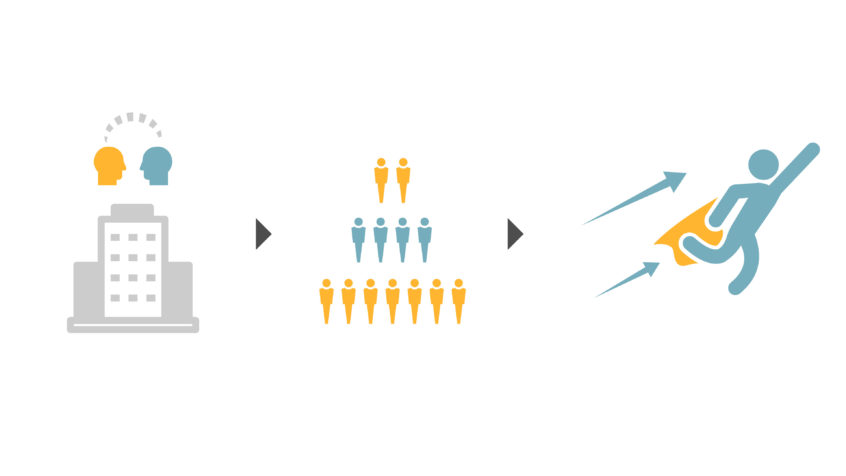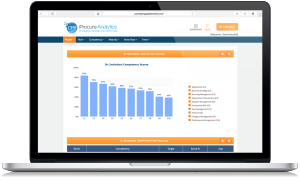Procurement Capability: People Matter Most
Procurement Capability: People Matter Most – There is no shortage of procurement experts prepared to offer their unique recipe for successful procurement transformation. Experts will offer improved processes, better use of technology, the need for management support, yet many procurement functions find lasting success elusive. Why is this?
Because it’s the people that matter most.
1. Its about the people stupid!
They forget transformation does not happen simply by providing the “tools”, it’s always the people that are the key factor in creating procurement success.
In the Supply Management article ‘The Lifeblood of Procurement,’ the writer makes the point that “people that do the work, people – not computers, strategies, or ‘world-class’ tools and templates”. It is one of the reasons why many procurement transformation efforts fail, resulting in “yet another transformation” effort a few years later.
The tools, templates, and systems are in place, training undertaken, and still the transformation effort does not stick. The ‘New Way’ is not truly embedded, because the people and environmental factors of transformation are not adequately addressed.
2. Achieve sustainable success
Successful procurement transformations occur when working with business partners and suppliers in the development and delivery of successful initiatives that result in an increased profit, improved business partner and supplier satisfaction, and optimized cash flow. In other words, contributing to the business goals.
So how is this achieved?
Well, it doesn’t matter which sector or industry you operate in; you need to align with the goals and needs of the organization.
If your business goals and objectives are not clear, then find them out! You need to attract, develop and retain people who have a well-developed instinct for value and the creativity to find it.
3. People are the only true asset any procurement function has
Just like the “one ring to rule them all” in the Lord of the Rings, people capability controls the critical success levers for enhancing procurement effectiveness.
People are the common thread that run through all elements of successful procurement transformation. So the importance of a skilled workforce is critical. Successful organizations recognize people matter most, and so they continuously invest in developing and maintaining best of breed skills to deliver their strategic objectives.
4. The heart & soul of an effective procurement organization
People make up the very essence of high performing procurement function; they are its heart and soul, its DNA.
For those of us old enough to remember the days when SAP, Ariba, & Kraljic did not exist, then those organizations at the leading edge of procurement still delivered on their brand promise. It wasn’t the strategies, processes or computers that made them successful; it was their people. If you were to take the people out, but provide all of today’s modern tools – procurement would fail to deliver on its promise.
5. What conclusion does all this lead us to?
Unless organizations invest in their most valuable resource. For the avoidance of doubt ‘its people’, the search for ‘world class’ or ‘procurement excellence’ is in vain. Like the knights of the crusades in search for the holy grail, like escapees from the foreign legion in pursuit of a mirage, Nirvana will always be out of reach.
6. The hidden human traits
The capability of your procurement team is not just dependent upon skills training; it is much more than that. Mindsets are critical also because it is a person’s mindset that will drive their behavior, and ultimately even the most technically skilled person will fail unless they demonstrate the right behaviors. These human traits are, therefore, critical to a successful transformation.
Development programs need to help buyers create the right thinking habits, ones that help them demonstrate more powerful behaviors to engage in relationships more effectively, especially with internal stakeholders and suppliers.
6.1 Mindset
 In a CPO Agenda article “More than just the goalkeeper” the writers point out a crucial question to answer for procurement professionals wishing to have influence in their organization:
In a CPO Agenda article “More than just the goalkeeper” the writers point out a crucial question to answer for procurement professionals wishing to have influence in their organization:
“who am I in this organization and what do I do?”
In considering this question, one of the conclusions drawn is the principal roadblock for CPO’s and the procurement profession getting to where they profess to want to be. Lies in the minds of the very professionals seeking the change.
The article also rightly points out that, such attributions of blame are often self-deceptions and that the main barrier to progress lies within the CPO’s span of control.
In our experience, everywhere we go we find procurement professionals who profess to want the strategic remit, but display a victim mindset (“they won’t let me”) so I don’t try anymore. The resulting weak behaviors demonstrated by the victims is observed by stakeholders, and the reputation of the procurement function damaged. This needs to change.
6.2 Self-awareness is vital
A reliable assessment of your team’s attributes and capabilities is the best way to bring self-awareness of your team into focus. Personal authenticity and legitimacy are powerful characteristics for influencing people. Put more directly, procurement professionals must have the skills they profess to have.
Until procurement professionals achieve a level of business acumen to influence at the top table. They may be able to dictate through their position authority (i.e., decide what their team does), but they will find it difficult to influence the wider organization and the business agenda.
Fundamentally for procurement, the type of personalities they attract into the profession and whether they really have the crucial ambition to be more strategic is a critical factor for the professions continued development. Our iProcure assessment tool provides all the flexibility needed to assess the current knowledge, and mindsets of job candidates before you hire them and for your team once you have. It provides the most reliable baseline data needed to develop meaningful personal development programs to build your teams procurement capability.
6.3 Behavior
Strategically aligned behavior is critical to procurement transformation. Capability development must, therefore, make a direct connection between business objectives and the behavior changes needed to achieve those objectives.
There are two types of behavior:
- task performance or in-role behavior (increasing efficiency)
- contextual performance or organizational behavioral norms (increasing organizational acceptance)
At Purchasing Practice, we have developed a joined up approach to building capability in procurement that recognizes the impact of the environment on individual performance. This methodology recognizes that skills and motivation are attributes of the individual, but they can only make a difference when the organization provides the appropriate context in which they can be applied. Behavior change may, therefore, have to be preceded by a change in organizational mindset (beliefs).
Without the change in organizational behavior learning application will be diluted at best, and the behavior change you’re counting on for new business outcomes may not happen. Personal assertiveness, ambition and creating a supportive environment, need to be a key part of the play book for CPOs and their team if they are to play a greater strategic role.
7. Personal Risk (The Brave CPO)
 As many have found out the hard way (myself included) there are also personal risks to consider. Experienced CPO’s will relate to the sensitivity required, likening it to walking on eggshells when talking openly and frankly about strategic matters. It takes bravery to put your head up above the parapet in a chicken shoot.
As many have found out the hard way (myself included) there are also personal risks to consider. Experienced CPO’s will relate to the sensitivity required, likening it to walking on eggshells when talking openly and frankly about strategic matters. It takes bravery to put your head up above the parapet in a chicken shoot.
Ultimately, however, although it is important to be sensitive to your environments culture and norms where there is uncertainty about the basic value of procurement, personal risk taking is central to being a good leader. If you are unwilling to commit yourself – when you know that there are personal consequences – it is difficult to ask others to do the same, and ultimately failure is only delayed not avoided.
So the DNA of a successful procurement leader must seek to balance the traditional remit of control and cost minimization, with a willingness to take risks to deliver breakthrough results that add strategic value. It often comes at the cost of butting heads against some powerful stakeholders.
Good leaders will encourage their team to take a risk, and encourage those around them to seek answers and solutions; and they develop people who will lead (in their own right), not follow.
8. Build a strategy for behavior change
Although the “Brave CPO” is a key part of the transition mix. It is also clear that they must have specific behavior change strategies for bringing about the desired transformation in the transition from “as is” to the “to be” state.
Most of the behavior change strategies, boil down to the following three “levers”:
- Increase the number of triggers leading to the desirable behavior.
- Enhance ability to perform the behavior (make it easier to do)
- Amplify motivation for doing the behavior with intrinsic and extrinsic motivators.
In each capability building effort you have to figure out how to get people to do something different:
- “What do you want people to do?”
- “Why aren’t they doing it then?”
9. CPP Model
The Purchasing Practice model operates on the framework that for people to perform a target behavior, they must:
- be sufficiently motivated
- have the ability to perform the behavior, and
- be triggered to perform the behavior
Our model provides CPO’s & HR leaders with a systemized methodology; to develop questions, collect the results and analyze the current state of data, processes, incentives, knowledge, capacity, and motives. To generate the conversation of how to implement effective behavior change in their organization.
9.1 Triggers:
a) Information
- Do employees know your organizations strategy and how their role contributes to it?
- Have you clearly communicated performance expectations to employees?
- Do employees understand the various aspects of their roles and the priorities for doing them?
- Are there clear and relevant performance aids available to guide the employees?
- Do you provide sufficient, timely behaviorally specific feedback regarding their performance?
- Do you have a performance management system to assist managers in describing expectations for both activities and results for the employee?
9.2 Capability:
a) Resources
- Do employees have the right tools and templates to do their jobs?
- Do employees have the time they need to do their jobs?
- Are procurement processes and procedures defined in such a way as to enhance employee performance?
- Is the work environment conducive to excellent performance?
b) Capacity
- Do the employees have the ability to learn what is expected for them to be successful?
- Are employees free from any emotional limitations that impede performance?
- Are employees recruited, selected, and matched to the realities of the work situation?
c) Knowledge and Skills
- Do the employees have the necessary knowledge to be successful at their jobs?
- Do the employees have the needed skills to be successful at their jobs?
- Do the employees have the needed experience to be successful at their jobs?
- Do employees have a systematic training program to enhance their knowledge and skills?
- Do employees understand how their roles impact organizational performance?
9.3 Motivation
a) Incentives
- Are there sufficient financial incentives present to encourage excellent performance?
- Are there sufficient non-financial incentives present to encourage excellent performance?
- Do measurement and reporting systems track appropriate activities and results?
- Are jobs enriched to allow for fulfillment of higher level needs?
- Are there opportunities for career development?
b) Motives
- Are the motives of the employees aligned with the incentives in the environment?
- Do employees desire to do the job to the expected standards?
- Are employees recruited and selected to match the realities of the work environment?
- Are there any rewards that reinforce poor performance or negative consequences for good performance?
- Do employees view the work environment as positive?
10. Applying the Model to Your Organization
The CPP model provides the standard terminology and methodology to collect hard data upon which to base future decisions? However, the CPO must aligning the goals and define what this data is going to do for you:
- What does success look like?
- How will you know you have successfully collected all the data you can and have analyzed it successfully?
- What specific, measurable, achievable, realistic, outcomes will make it easier to evaluate the success of the selected interventions?
When defining measurable objectives, the analysis of the data must demonstrate how it all fits together to drive the desired behaviors. CPO’s must create an action plan to implement interventions that will support the desired behaviors. Both during the implementation of your plan and after the plan is in place, and your team engaged in their roles in the months and years to come.
Nuff said…
Purchasing Practice has developed the Procurement Capability Chain and the iProcure platform to help organizations embed capability in procurement via program embedded learning. We can also provide advice and valuable templates and guides to support a best practice approach.
See further details of our iProcure platform here




